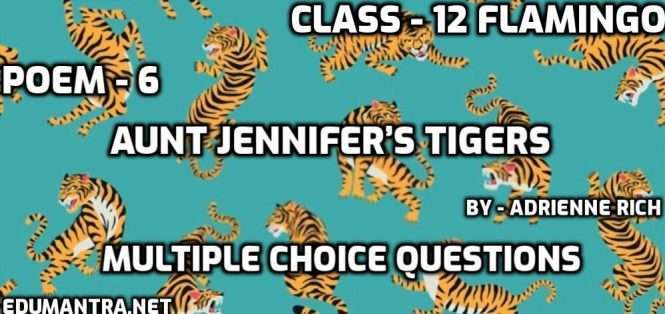
Aunt Jennifer’s Tigers
By- Adrienne Rich
MULTIPLE CHOICE QUESTIONS
1. What is Aunt Jennifer doing with wool?
(a) she is embroidering a wall panel (b) she is knitting a scarf
(c) she is making a ball of wool (d) she is knitting a cap
2. What do her ‘fluttering fingers’ find hard?
(a) to pull the ivory needle (b) to roll the ball off the wall
(c) to thread the needle (d) to draw the sketch of tigers
3. The massive weight of Uncle’s wedding band is a subtle reference to
(a) male oppression
(b) suppression at the hands of her husband
(c) the heavy gold ring
(d) the huge gold wedding band makes her uncomfortable
4. What was lying heavily?
(a) her wedding band (b) the Tigers on the screen
(c) uncle of the poet (d) Aunt Jennifer’s cat
5. The word ‘prance’ in the poem means
(a) to jump ahead (b) to dance
(c) to eat (d) to prowl
6. ‘Denizens’ in the poem means
(a) resting place (b) forest
(c) residents (d) slum areas
7. The word ‘chivalric’ in the context means
(a) timid (b) arrogant
(c) honourable and brave (d) malicious
8. Sits heavily upon Aunt Jennifer’s hand. This line means that
(a) Aunt Jennifer is a sufferer in a male-dominated society (b) is a heavy object
(c) hard to carry (d) cannot lift it at all
9. Aunt Jennifer’s family consists of
(a) she and her husband (b) she and her tigers
(c) she and her kids (d) she and her servants
10. ‘Terrified hands’ of Aunt Jennifer means
(a) hard and bitter experience of married life (b) scared hands
(c) un-manicured hands (d) soft and nice hands
Answers:-
| 1.(a) she is embroidering a wall panel |
| 2. (b) to roll the ball off the wall |
| 3.(b) suppression at the hands of her husband |
| 4. (a) her wedding band |
| 5.(a) to jump ahead |
| 6. (c) residents |
| 7.(c) honorable and brave |
| 8.(a) Aunt Jennifer is a sufferer in a male-dominated society |
| 9.(a) she and her husband |
| 10.(a) hard and bitter experience of married life |
English MCQ Aunt Jennifer’s Tigers Objective quiz Class 12 Part – 1
English MCQ Aunt Jennifer’s Tigers Objective quiz Class 12 Part – 3
Want to Read More Check Below:-
Aunt Jennifer’s Tigers- About the Author
Aunt Jennifer’s Tigers- Theme & Message
Aunt Jennifer’s Tigers- Chapter Nutshell & Literary Devices
Aunt Jennifer’s Tigers- Short & Detailed Summary
Aunt Jennifer’s Tigers- Extract Based comprehension test Questions
Aunt Jennifer’s Tigers- Important Extra Questions Short Answer Type